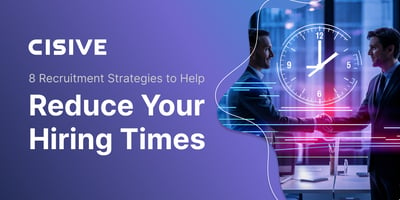

Regardless of the quality of your product or your brand’s reputation, your hiring strategy may be...

Most managers and HR departments have to deal with bad employees at some point. Understanding what to do with a bad employee helps maintain a healthy, effective work environment.
While it might be natural to avoid confrontation, one bad employee can affect the entire team, so dealing with problems quickly helps reduce overall workplace conflict.
QuickRead:Some of the things this article addresses regarding dealing with problem workplace behaviors include:
|
A bad employee can affect workplace morale, hamper the work of other team members, and damage your company's reputation with customers. Knowing what to do with a bad employee is essential for maintaining a functional workplace.
Here's what you need to deal with a bad employee:
Bad employees disrupt normal workplace activity and create a toxic work environment. Their behavior can range from minor annoyances that undermine others in the workplace to larger issues that damage customer relationships or prevent your company from completing necessary business operations.
In some cases, bad employees actively violate company policies, making it easy to identify the problem and take appropriate action. Job termination is an appropriate response to an employee who steals company property, harasses other employees, or makes threats against coworkers.
Sometimes, bad employee behavior isn't quite to the level of policy violation or illegal activity. Employees exhibiting toxic behavior, such as shirking work responsibilities or causing workplace drama, can often change their attitudes with intervention from HR.
Here are a few behaviors that let you know you're dealing with bad employees.
Deadlines help keep management and employees on track, and workers who consistently miss deadlines can harm their team members and impact client satisfaction.
Missed deadlines could cause delays in delivering goods or services to clients. Someone who consistently turns in work late can also put extra stress on coworkers who need to pick up the slack.
Employees who gossip or try to sabotage others on their team create a toxic work culture that makes everyone else uncomfortable.
Over time, workplace drama can result in the loss of good employees. One report found that toxic workplace culture results in excess turnover, with approximately 20% of employees quitting their jobs due to bad company culture.
A smooth-running workplace needs employees who are happy to be there. Employees with negative attitudes affect the morale of those around them and can stir up trouble in an otherwise pleasant office environment.
An employee with a negative attitude might frequently complain about the workload or specific tasks, consistently blame others for poor work performance, or become over-dramatic about small problems that arise.
Engaged employees show initiative and try to interact with others in the workplace. If an employee only does the minimum required, shows no interest in learning new skills, and never contributes suggestions during team meetings, this could be a sign of a bad employee.
Employees who spend more time chatting with coworkers, taking personal calls, or scrolling social media than doing their work tasks could be costing the company time and money.
Dealing with a bad employee comes down to:
Here are some ways to successfully deal with a bad employee.
Approaching an employee with vague references to bad behavior is unlikely to achieve the desired results. Tracking specific incidents over a few weeks or months lets you present this data to the employee during a performance meeting so you can develop a plan for improvement together.
Documenting employee behavior also helps if you eventually need to fire the employee. Having a clear record of past behavior lets you see at a glance how big the problem is.
The only way to improve a workplace situation is to determine the underlying cause. Set up a meeting with the employee to discuss the problems you've identified.
In some cases, simply listening to the employee may change the situation. If problems arise because the employee doesn't feel heard, a simple one-on-one meeting with management or HR could set things on the right track.
Keep an open mind during this first discussion. In some cases, the employee may bring up legitimate issues with coworkers or the workplace environment that need to be adjusted.
Bad employees often want to perform better but might not know what they need to do. Explaining exactly what you expect from them could help employees change their behavior.
Consider creating a formal plan for improvement, including timelines and objectives. Schedule future meetings to assess whether the employee is meeting those milestones and discuss the consequences if they fail to follow the plan.
Take the time to develop a consistent process for addressing bad employee behavior and stick to that process no matter who in your company is causing problems.
Treating employees differently because of their relationship with you or their coworkers could be a problem when it comes to implementing actual change in the workplace. Having a written policy for corrective actions gives you something to fall back on when an uncomfortable situation arises.
In many cases, it's easier to prevent bad employee behavior than to deal with it after the fact. Background checks and screening can help you identify potentially bad employees before hiring them.
If a new employee begins to exhibit negative behaviors, address the problem quickly before it spirals out of control or affects others in the workplace.
You might also want to implement conflict resolution training in your workplace to help employees learn how to address issues and manage workplace conflict before small problems become insurmountable ones.
Understand that some employees can't be rehabilitated, especially if they are breaking company policies, upsetting customers, or causing strife between other employees. Quickly firing the problematic employee and moving on might be the best solution for everyone.
Dealing with a bad employee brings its own set of challenges. Cisive can help you prevent problems in the first place with efficient, accurate employee background screening services that make it easy to hire great employees in the first place.
Some common challenges when dealing with a bad employee include:
Dealing with a bad employee can be stressful for HR and management, but letting problem behavior continue could cause more stress in the long run. Once you've identified the root causes of an employee's bad behavior, determining how to handle the situation can be one of the toughest decisions you need to make.
Reduce the risk of hiring bad employees with a thorough background check before bringing a new employee on board. Contact Cisive today to book a consultation about employee background screening.
A: Bad employees often fall into a few specific categories:
A: Some bad employee behavior can be corrected, especially if management or HR intervenes quickly. Serious problems, such as breaking company policies or angering customers, may be unfixable, so you might have to make tough decisions regarding retraining or letting the employee go.
A: Addressing the situation quickly and directly is the best way to handle toxic employees. Depending on the problem, you might choose to fire the employee or develop a detailed plan to correct the behavior.
A: A positive work environment results when management and employees work together toward the same goals without excess strife. Hiring great employees at the start and weeding out problem behaviors as soon as possible can help achieve this goal.

Regardless of the quality of your product or your brand’s reputation, your hiring strategy may be...

Recruiting is a lot of work, but it’s one of the best kinds of work. When you’re recruiting, it...

Comprehensive background checks can alert employers to potential issues with prospective...